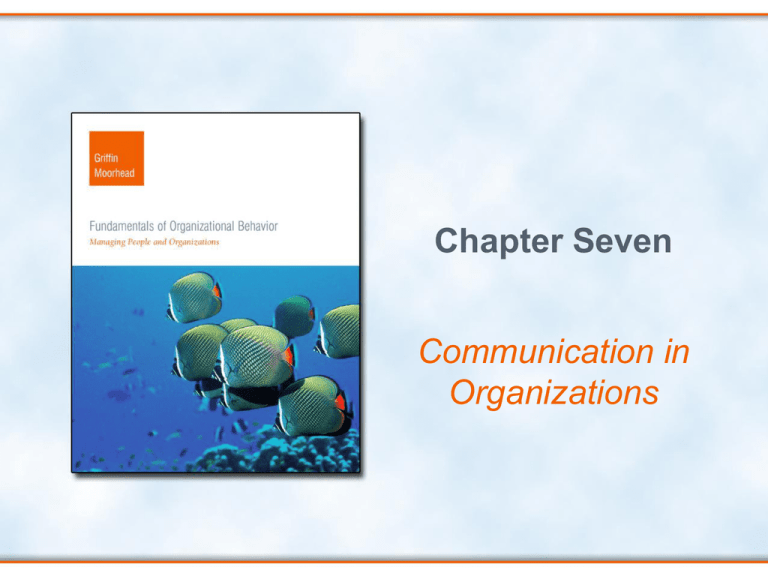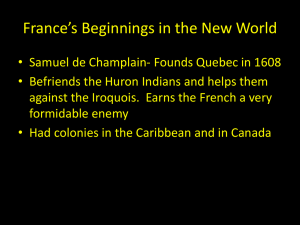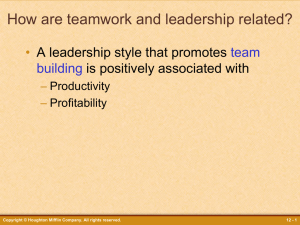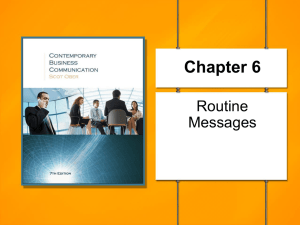
Chapter Seven
Communication in
Organizations
Chapter Objectives
• Discuss the nature of communication in
organizations.
• Describe the primary methods of
communication.
• Describe the communication process.
• Explain how information technology affects
communication.
• Describe the basic kinds of communication
networks.
• Discuss how communication can be
managed in organizations.
Copyright © Houghton Mifflin Company. All rights reserved.
7-2
The Nature of Communication in
Organizations
• Communication
– The social process in which two or more
parties exchange information and share
meaning.
• Purposes of Communication in
Organizations
– Communication among individuals and
groups is vital in all organizations.
Copyright © Houghton Mifflin Company. All rights reserved.
7-3
Figure 7.1: Three Purposes of Organizational
Communication
Copyright © Houghton Mifflin Company. All rights reserved.
7-4
Communication Across Cultures
• Communication is an element of
interpersonal relations that obviously is
affected by the international environment,
partly because of language issues and partly
due to coordination issues.
• Language
– Differences in language are compounded by the
fact that the same word can mean different things
in different cultures.
• For example, Coca-Cola meant “bite the head of a dead
tadpole” in the 1st Chinese characters used in the
product’s ads.
Copyright © Houghton Mifflin Company. All rights reserved.
7-5
Communication Across Cultures (continued)
• Coordination
– International communication is closely related to
issues of coordination.
• For example, an American manager who wants to speak
with his or her counterpart in Hong Kong or Rome, must
contend not only with language differences but also with
a time difference of many hours.
– Consequently organizations are employing
increasingly innovative methods for coordinating
their activities in scattered parts of
the globe.
Copyright © Houghton Mifflin Company. All rights reserved.
7-6
Figure 7.2: Methods of Communication in
Organizations
Copyright © Houghton Mifflin Company. All rights reserved.
7-7
Nonverbal Communication
• Includes all the elements associated
with human communication that are not
expressed orally or in writing.
– Examples of nonverbal communication
include:
• Facial expressions
• Physical movements
• Environmental elements such as buildings,
office space, and furniture
Copyright © Houghton Mifflin Company. All rights reserved.
7-8
Figure 7.3: The Communication Process
Copyright © Houghton Mifflin Company. All rights reserved.
7-9
The Communication Process
• Source
– The source is the individual, group, or
organization interested in communicating
something to another party.
• Encoding
– The process by which the message is
translated from an idea or a thought into
transmittable symbols.
Copyright © Houghton Mifflin Company. All rights reserved.
7-10
The Communication Process (continued)
• Transmission
– The process through which the symbols
that represent the message are sent to the
receiver.
• Decoding
– The process by which the receiver of the
message interprets its meaning.
Copyright © Houghton Mifflin Company. All rights reserved.
7-11
The Communication Process
(continued)
• Receiver
– The individual, group, or organization that
perceives the encoded symbols.
• Feedback
– The process in which the receiver returns a
message to the sender indicating receipt and
understanding of the message.
• Noise
– Any disturbance in the communication process
that interferes with or distorts communication.
Copyright © Houghton Mifflin Company. All rights reserved.
7-12
Electronic Information Processing and
Telecommunications
• Changes in the workplace are occurring at an
astonishing rate.
– Many “communications-focused” innovations are
based on new technologies:
•
•
•
•
•
Computerized information processing systems
New types of telecommunication systems
The Internet
Organizational Intranets
Various combinations of these technologies
Copyright © Houghton Mifflin Company. All rights reserved.
7-13
Small-Group Networks
• Wheel network – information flows between the
person at the end of each spoke and the person in
the middle.
• Chain network – each member communicates with
the person above and below, except for the
individuals on each end, who communicate with
only one person.
• Circle network – each member communicates with
the people on both sides but with no one else.
• All-channel network – all members communicate
with all other members.
Copyright © Houghton Mifflin Company. All rights reserved.
7-14
Figure 7.4: Small-Group Communication
Network
Copyright © Houghton Mifflin Company. All rights reserved.
7-15
Figure 7.4: Small-Group Communication
Network
Copyright © Houghton Mifflin Company. All rights reserved.
7-16
Organizational Communication Networks
• Organizational Chart
– An organization chart shows reporting
relationships from the line worker up to the CEO of
the firm.
– Communication Flows
• Downward communication generally provides directions,
whereas upward communication provides feedback to
top management.
• Communication that flows horizontally or crosses
traditional reporting lines is usually related to task
performance.
Copyright © Houghton Mifflin Company. All rights reserved.
7-17
Organizational Communication Networks
(continued)
• Communication Flows (continued)
– Organizational communication networks may
diverge from reporting relationships as employees
seek better information with which to do their jobs.
• Employees often find that the easiest way to get their
jobs done or obtain the necessary information is to go
directly to employees in other departments rather than
through the formal channels shown on the organization’s
chart.
Copyright © Houghton Mifflin Company. All rights reserved.
7-18
Figure 7.5: Comparison of an Org. Chart and
the Organization’s Communication Network
Copyright © Houghton Mifflin Company. All rights reserved.
7-19
Roles People Play in Organizational
Communication
• Gatekeeper
– A strategic position in the network that
allows him or her to control information
moving in either direction through a
channel.
• Liaison
– A bridge between groups, tying groups
together and facilitating the communication
flow needed to integrate group activities.
Copyright © Houghton Mifflin Company. All rights reserved.
7-20
Roles People Play in Organizational
Communication (continued)
• Cosmopolite
– A link between the organization and the
external environment; this person may also
be an opinion leader in the group.
• Isolate
– A person in the organization who tends to
work alone and to interact and
communicate little with others.
Copyright © Houghton Mifflin Company. All rights reserved.
7-21
Table 7.1: Improving the Communication
Process
Copyright © Houghton Mifflin Company. All rights reserved.
7-22
How Communication Problems Occur
• Semantics
– The study of language forms and semantic
problems occur when people attribute different
meanings to the same works or language
problems
• Jargon
– The specialized or technical language of a trade,
field, profession, or social group.
• The use of jargon is acceptable if the receiver is familiar
with it; otherwise, it should be avoided.
Copyright © Houghton Mifflin Company. All rights reserved.
7-23
How Communication Problems Occur
(continued)
• Receiver
– Several communication problems originate in the
receiver:
• Selective attention exists when the receiver attends only
to selected parts of a message—a frequent occurrence
with oral communication.
• Value judgments are influenced by the degree to which a
message reinforces or challenges the receiver’s basic
personal beliefs.
• The receiver may also judge the credibility of the source
of the message.
Copyright © Houghton Mifflin Company. All rights reserved.
7-24
How Communication Problems Occur
(continued)
• Inadequate Feedback
– Lack of feedback can cause at least two problems.
• The source may need to send another message that
depends on the response to the first; if the sources
receives no feedback, s/he may not send the second
message or may be forced to send the original message
again.
• The receiver may act on the unverified message; if s/he
misunderstood the message, the resulting act may be
inappropriate.
Copyright © Houghton Mifflin Company. All rights reserved.
7-25
Improving Organizational Factors in
Communication
• Organizational factors that can create
communication breakdowns or barriers
include noise, status differences, time
pressures, and overload.
• Reduce Noise
– Noise is a primary barrier to effective
communication.
• A common form of noise is the rumor grapevine, an
informal system of communication that coexists with the
formal system that distorts organizational
communication.
Copyright © Houghton Mifflin Company. All rights reserved.
7-26
Improving Organizational Factors in
Communication (continued)
• Foster Informal Communication
– Communication in well-run companies was
once described as “a vast network of
informal, open communication.”
• Informal communication fosters mutual trust,
which minimizes the effects of status
differences.
• Open communication can also contribute to
better understanding between diverse groups in
an organization.
Copyright © Houghton Mifflin Company. All rights reserved.
7-27
Improving Organizational Factors in
Communication (continued)
• Develop a Balanced Information
Network
– Organizations need to balance information
load and information processing
capabilities and take care not to generate
more information than people can handle.
Copyright © Houghton Mifflin Company. All rights reserved.
7-28












